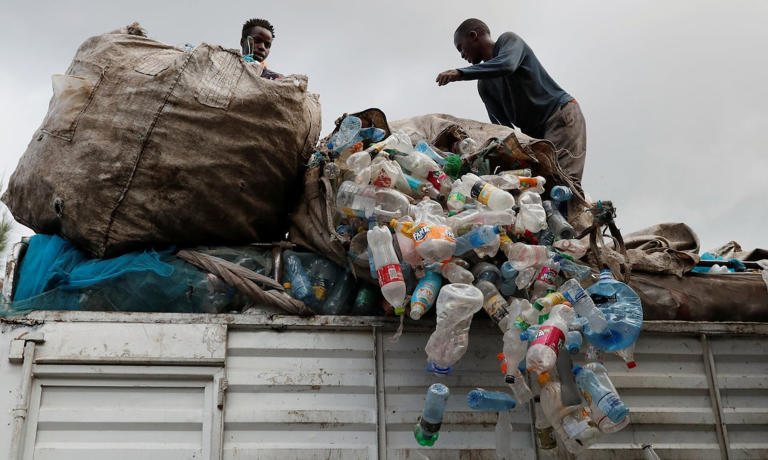Story by Jill English • CBC
A key week of negotiations kicks off Tuesday, as representatives from 176 countries descend on Ottawa to tackle global challenges posed by plastics.
The fourth and penultimate instalment of talks tees up a final session later this year in Korea, where parties hope to sign onto a binding international treaty on plastic pollution.
"This process is really a once-in-a-generation opportunity to end plastic pollution. It's a historic process," said Eirik Lindebjerg, the World Wildlife Fund's global plastics policy lead.
To date, negotiations have amounted to a bulky 69-page draft. Negotiators will now work to whittle that text down to a list of core issues. Succeeding at that will be key to scoring a global treaty at the final session.
In the draft's opening lines, the parties agree that "rapidly increasing levels of plastic pollution represent a serious environmental problem at a global scale."
But the tension point is whether plastic production or waste management should be the focus of the agreement, with conflicting interests slowing negotiations to date.
"Ottawa really needs to be a turning point," said Graham Forbes, the global plastics project leader at Greenpeace. "We're in a make-or-break moment for the global plastics treaty negotiations."

Greenpeace activists call for action ahead of the second session of global negotiations on plastic pollution, hosted in Paris in May 2023.
Plastics are everywhere
Plastic waste is a ubiquitous global problem, with seven billion tonnes of the synthetic material generated globally since the 1950s, according to the United Nations Environment Programme, with some 98 per cent of single-use plastic produced directly from fossil fuels, rather than recycled materials.
What If
What If We Turned Plastic Into Fuel?Duration 5:34 View on Watch
The OECD estimates that just nine per cent of plastic created has ever been recycled.
Most of it ends up in landfill, some is burned, and other plastic pollution ends up in rivers, lakes and oceans. Trillions of pieces of plastic are harming marine ecosystems, entangling some creatures and being eaten by others. Scientists estimate most seabirds now have plastic in their guts.
"Plastic pollution is fuelling what we call the triple planetary crisis," said Forbes. "It's accelerating climate change, decimating biodiversity and threatening to pollute every corner of our planet, including the human body."
Through their lifecycle, the OECD estimates plastics account for approximately 3.4 per cent of emissions making them what it calls a significant contributor to rising global temperatures.

Workers in Nairobi offload plastic bottles for recycling from a truck at the Dawn to Glory PET flakes export company.
The UNEP estimates that, without action, nearly a fifth of the world's shrinking carbon budget — the emissions allowance to keep warming under 1.5 degrees above pre-industrial levels — will be taken up by plastic production and use by 2040.
Earlier negotiations fell short
While it's not clear what form a global plastics treaty might take this, a 2022 Ipsos survey suggests there is public appetite to do something.
In the poll, conducted online across 28 countries, 75 per cent of people surveyed want to see a ban on single use plastics as soon as possible, and most supported an international treaty to combat plastic pollution.
A core group of 60 countries, including Canada, have taken that ambition a step further, establishing the High Ambition Coalition to End Plastic Pollution, and aiming to end plastic pollution by 2040.
But international agreements are complex, and earlier sessions in Punta del Este, Uruguay, Paris, and Nairobi are widely considered to have fallen short.
"We see at these negotiations that industry associations, from oil and gas and from the petrochemical sector are very active, and are pushing often against global binding action," said Lindebjerg.
"The fossil fuel industry is using plastics as a way to offset declines in energy and transportation as the world moves towards a low carbon, fossil fuel-free future. And they're just flooding the world with plastics," said Forbes.
The Canadian Chemistry Industry Association, which represents plastic companies in Canada, says that's not the position of its members.
"I think everyone is laser-focused on ensuring that this gets done by the end of the year," said the organization's VP of policy, Isabelle Des Chênes, in an interview with CBC News.
Curbing production and improving waste management
The industry is drawing attention to opportunities to improve reuse and recycling initiatives.
"There's a lot of plastic and there's a lot of plastic for a reason," said Des Chênes. "It helps to preserve our food [...] it's really important in the transportation phase."
She hopes the treaty will address how to make plastics better.
"It really needs to look at product design, how the products are developed, whether it's with recycled content, whether they're designed for reuse and resell, whether they're designed for recyclability."
Other advocacy groups believe the treaty's emphasis should be on production.
"I think the worst case scenario for Ottawa is that they remove options to address plastic production. We start to craft a waste management treaty that throws good money after bad, and continue the illusion that we can recycle our way out of this," said Forbes.
In reality, the proposed treaty aims to tackle both production and waste.

Negotiators meet for the second session of talks around a future treaty on tackling plastic pollution at the UNESCO Headquarters in Paris on May 29, 2023. (Stephanie Lecocq/Reuters)© Provided by cbc.ca
"There is a broad majority of countries that want to see a strong treaty, a treaty with common global rules throughout the lifecycle of plastics." said Lindebjerg.
INC-4, as the Canada-based session is called, is expected to host more than 4,200 participants, making it the most attended session since INC-1 kick-started negotiations in Uruguay in November 2022.
INC-4 will continue through until April 29, with negotiators resuming talks for the fifth and final session in Busan, Republic of Korea in late-November.
With files from Susan Ormiston and Sarah Bridge

 Global News
Global News





